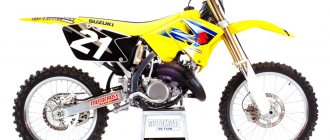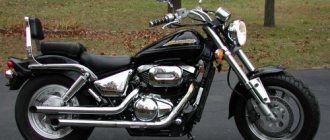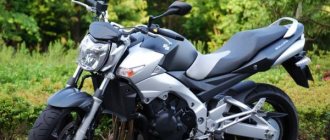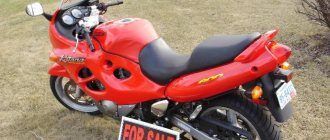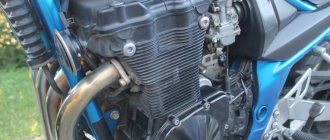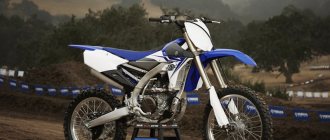| Suzuki RM250 (1976-1978) | Suzuki RM250 (1979) | Suzuki RM250 (1982-1983) | Suzuki RM250 (1984-1985) |
| Suzuki RM250 (1986-1988) | Suzuki RM250 (1989-1994) | Suzuki RM250 (1995-1996) | Suzuki RM250 (1997) |
| Suzuki RM250 (1998) | Suzuki RM250 (1999-2000) | Suzuki RM250 (2001) | Suzuki RM250 (2002) |
| Suzuki RM250 (2003) | Suzuki RM250 (2004) | Suzuki RM250 (2005) | Suzuki RM250 (2006-2008) |
Model of the motocross motorcycle Suzuki RM 250
was first introduced in 1976 - a motorcycle of this generation has a rather archaic (by modern standards) appearance, simple suspension, drum brakes and an air-cooled engine. In the 80s, the model was updated, acquiring more familiar features of motocross motorcycles and receiving a new liquid-cooled engine, and by 1989, an inverted fork. It is from this generation (late 80s - early 90s) that it is advisable to consider the Suzuki RM250 model.
In the 90s and 2000s, the Suzuki RM250 also underwent several restylings, which concerned the appearance, engine and chassis (suspension tuning and geometry), but the main technical parameters remained unchanged - a steel semi-duple frame, sports adjustable suspension in the form of an inverted fork type in front and a progressive pendulum with a monoshock absorber in the rear, 2-stroke liquid-cooled engine, disc brakes, carburetor power system, 5-speed gearbox and 96 kg of dry weight.
2008 was the last year of production of the model, after which it finally left the market and gave way to a 4-stroke version - the Suzuki RM-Z250.
The main competitors of the Suzuki RM 250 in the class:
- Honda CR250R (aluminum frame)
- Kawasaki KX 250 (steel frame)
- Yamaha YZ 250 (aluminum frame)
Brief history of the model
- 1982 - Model
: Suzuki RM250 (North America).
Factory designation:
RM250Z.
- 1983 - Model
: Suzuki RM250 (North America).
Factory designation:
RM250D.
- 1984 - Model
: Suzuki RM250 (North America).
Factory designation:
RM250E.
- 1985 - Model
: Suzuki RM250 (North America).
Factory designation:
RM250F.
- 1986 - Model
: Suzuki RM250 (North America).
Factory designation:
RM250G.
- 1987 - Model
: Suzuki RM250 (North America).
Factory designation:
RM250H.
- 1988 - Model
: Suzuki RM250 (North America).
Factory designation:
RM250J.
- 1989 - Model
: Suzuki RM250 (North America, Europe and others).
Factory designation:
RM250K.
- 1990 - Model
: Suzuki RM250 (North America, Europe and others).
Factory designation:
RM250L.
- 1991 - Model
: Suzuki RM250 (North America, Europe and others).
Factory designation:
RM250M.
- 1992 - Model
: Suzuki RM250 (North America, Europe and others).
Factory designation:
RM250N.
- 1993 - Model
: Suzuki RM250 (North America, Europe and others).
Factory designation:
RM250P.
- 1994 - Model
: Suzuki RM250 (North America, Europe and others).
Factory designation:
RM250R.
- 1995 - Model
: Suzuki RM250 (North America, Europe and others).
Factory designation:
RM250S.
- 1996 - Model
: Suzuki RM250 (North America, Europe and others).
Factory designation:
RM250T.
- 1997 - Model
: Suzuki RM250 (North America, Europe and others).
Factory designation:
RM250V.
- 1998 - Model
: Suzuki RM250 (North America, Europe and others).
Factory designation:
RM250W.
- 1999 - Model
: Suzuki RM250 (North America, Europe and others).
Factory designation:
RM250X.
- 2000 - Model
: Suzuki RM250 (North America, Europe and others).
Factory designation:
RM250Y.
- 2001 - Model
: Suzuki RM250 (North America, Europe and others).
Factory designation:
RM250K1.
- 2002 - Model
: Suzuki RM250 (North America, Europe and others).
Factory designation:
RM250K2.
- 2003 - Model
: Suzuki RM250 (North America, Europe and others).
Factory designation:
RM250K3.
- 2004 - Model
: Suzuki RM250 (North America, Europe and others).
Factory designation:
RM250K4.
- 2005 - Model
: Suzuki RM250 (North America, Europe and others).
Factory designation:
RM250K5.
- 2006 - Model
: Suzuki RM250 (North America, Europe and others).
Factory designation:
RM250K6.
- 2007 - Model
: Suzuki RM250 (North America, Europe and others).
Factory designation:
RM250K7.
- 2008 - Model
: Suzuki RM250 (North America, Europe and others).
Factory designation:
RM250K8.
Suzuki RM-Z250 chassis and handling
The Suzuki RM-Z250 handles wonderfully. It's no secret that Suzuki's motocross models are known for their good handling, and the RM-Z250 lives up to that reputation, turning in well while maintaining straight-line stability. Even on unusually stiff suspensions, it easily goes through ruts, but if it were equipped with softer springs, it would be generally ideal in handling.
With such excellent turning, it is also moderately stable at high speeds (in third gear and higher), which, for example, the Honda CRF250R cannot boast of. In general, its chassis is very good, and the suspension components, brakes, and wheels are of very decent quality. The only thing I would change is the grips, I didn’t like the standard ones.
As for ergonomics, the motorcycle is a little tall, but at the same time compact. The Renthal Fatbar handlebar, with an 821 camber, is slightly lower than the 839 camber on the 2021 Honda CRF250R and 2021 Kawasaki KX250. Even with stiffer fork springs, it has an upturned rear end, just like the Honda, by the way. It's narrow between the knees and fits smaller riders very well. The box foot is a bit short. The seat is flat and long, and with the low handlebars you feel distinctly ON the motorcycle rather than IN the saddle.
Suzuki RM-Z250
Specifications
Technical characteristics of Suzuki RM250 (2007, RM250K7):
| Model | Suzuki RM250 |
| Motorcycle type | cross |
| Year of issue | 1976-2008 |
| Frame | steel half-duplex |
| engine's type | 1-cylinder, 2-stroke |
| Working volume | 249 cm³ |
| Bore/Stroke | 66.4 x 72.0 mm |
| Compression ratio | 8.6:1 (with the power valve open); 10.4:1 (with power valve closed) |
| Cooling | liquid |
| Number of valves per cylinder | intake reed valve |
| Fuel supply system | Carburetor, 1x Keihin PWK38S |
| Ignition type | CDI |
| Maximum power | 55.0 hp (40.5 kW) at 8500 rpm |
| Maximum torque | 50.0 Nm (5.1 kg*m) at 7500 rpm |
| Clutch | Multi-disc in oil bath, cable drive |
| Transmission | 5-speed |
| type of drive | chain |
| Front tire size | 80/100-21 51M |
| Rear tire size | 110/90-19 62M |
| Front brakes | 1 disc, 250 mm, 2-piston caliper |
| Rear brakes | 1 disc, 240 mm, 1-piston caliper |
| Front suspension | Inverted fork (adjustable), travel - 310 mm |
| Rear suspension | Progressive pendulum with monoshock absorber (adjustable), stroke - 310 mm |
| Motorcycle length | 2170 mm |
| Motorcycle width | 830 mm |
| Motorcycle height | 1280 mm |
| Wheelbase | 1465 mm |
| Seat height | 950 mm |
| Minimum ground clearance (clearance) | 350 mm |
| Acceleration 0-100 km/h (0-60 mph) | |
| Maximum speed | |
| Gas tank capacity | 8.0 l |
| Motorcycle weight (dry) | 96.0 kg |
Suspensions Suzuki RM-Z250
The 2021 Suzuki RM-Z250 is equipped with a KYB Air-Oil Separate (AOS) spring fork and a KYB shock absorber with separate adjustments for smoothing fast and slow compression, fast and slow rebound, and spring preload. These are amazing suspension components, perhaps the best in their class.
But, unfortunately, when Suzuki designers chose the factory settings for these suspensions, they apparently did not think about comfort. The monoshock absorber is quite rigid, but in principle adjustable. But the fork is clearly poorly calculated: springs of 5.0 Nm in the front and 5.2 Nm in the rear are more common on heavier and more powerful 450 cc motorcycles, and there is a feeling that the stock RM-Z250 suspension would be suitable for a professional cross racer for a full-fledged supercross track... Or perhaps a fat newbie
